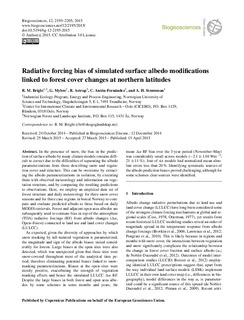| dc.contributor.author | Bright, Ryan M. | |
| dc.contributor.author | Myhre, Gunnar | |
| dc.contributor.author | Astrup, Rasmus Andreas | |
| dc.contributor.author | Antón-Fernández, Clara | |
| dc.contributor.author | Strømman, Anders Hammer | |
| dc.date.accessioned | 2019-11-13T10:31:21Z | |
| dc.date.available | 2019-11-13T10:31:21Z | |
| dc.date.created | 2015-06-12T13:25:57Z | |
| dc.date.issued | 2015 | |
| dc.identifier.citation | Biogeosciences. 2015, 12 (7), 2195-2205. | nb_NO |
| dc.identifier.issn | 1726-4170 | |
| dc.identifier.uri | http://hdl.handle.net/11250/2628148 | |
| dc.description.abstract | In the presence of snow, the bias in the prediction of surface albedo by many climate models remains difficult to correct due to the difficulties of separating the albedo parameterizations from those describing snow and vegetation cover and structure. This can be overcome by extracting the albedo parameterizations in isolation, by executing them with observed meteorology and information on vegetation structure, and by comparing the resulting predictions to observations. Here, we employ an empirical data set of forest structure and daily meteorology for three snow cover seasons and for three case regions in boreal Norway to compute and evaluate predicted albedo to those based on daily MODIS retrievals. Forest and adjacent open area albedos are subsequently used to estimate bias in top-of-the-atmosphere (TOA) radiative forcings (RF) from albedo changes (Δα, Open–Forest) connected to land use and land cover changes (LULCC).
As expected, given the diversity of approaches by which snow masking by tall-statured vegetation is parameterized, the magnitude and sign of the albedo biases varied considerably for forests. Large biases at the open sites were also detected, which was unexpected given that these sites were snow-covered throughout most of the analytical time period, therefore eliminating potential biases linked to snow-masking parameterizations. Biases at the open sites were mostly positive, exacerbating the strength of vegetation masking effects and hence the simulated LULCC Δα RF. Despite the large biases in both forest and open area albedos by some schemes in some months and years, the mean Δα RF bias over the 3-year period (November–May) was considerably small across models (−2.1 ± 1.04 Wm−2; 21 ± 11%); four of six models had normalized mean absolute errors less than 20%. Identifying systematic sources of the albedo prediction biases proved challenging, although for some schemes clear sources were identified. | nb_NO |
| dc.language.iso | eng | nb_NO |
| dc.publisher | European Geosciences Union (EGU) | nb_NO |
| dc.rights | Navngivelse 4.0 Internasjonal | * |
| dc.rights.uri | http://creativecommons.org/licenses/by/4.0/deed.no | * |
| dc.title | Radiative forcing bias of simulated surface albedo modifications linked to forest cover changes at northern latitudes | nb_NO |
| dc.type | Journal article | nb_NO |
| dc.type | Peer reviewed | nb_NO |
| dc.description.version | publishedVersion | nb_NO |
| dc.source.pagenumber | 2195-2205 | nb_NO |
| dc.source.volume | 12 | nb_NO |
| dc.source.journal | Biogeosciences | nb_NO |
| dc.source.issue | 7 | nb_NO |
| dc.identifier.doi | 10.5194/bg-12-2195-2015 | |
| dc.identifier.cristin | 1247875 | |
| dc.description.localcode | © Author(s) 2015. This work is distributed under the Creative Commons Attribution 3.0 License. | nb_NO |
| cristin.unitcode | 194,64,25,0 | |
| cristin.unitname | Institutt for energi- og prosessteknikk | |
| cristin.ispublished | true | |
| cristin.fulltext | original | |
| cristin.qualitycode | 1 | |

